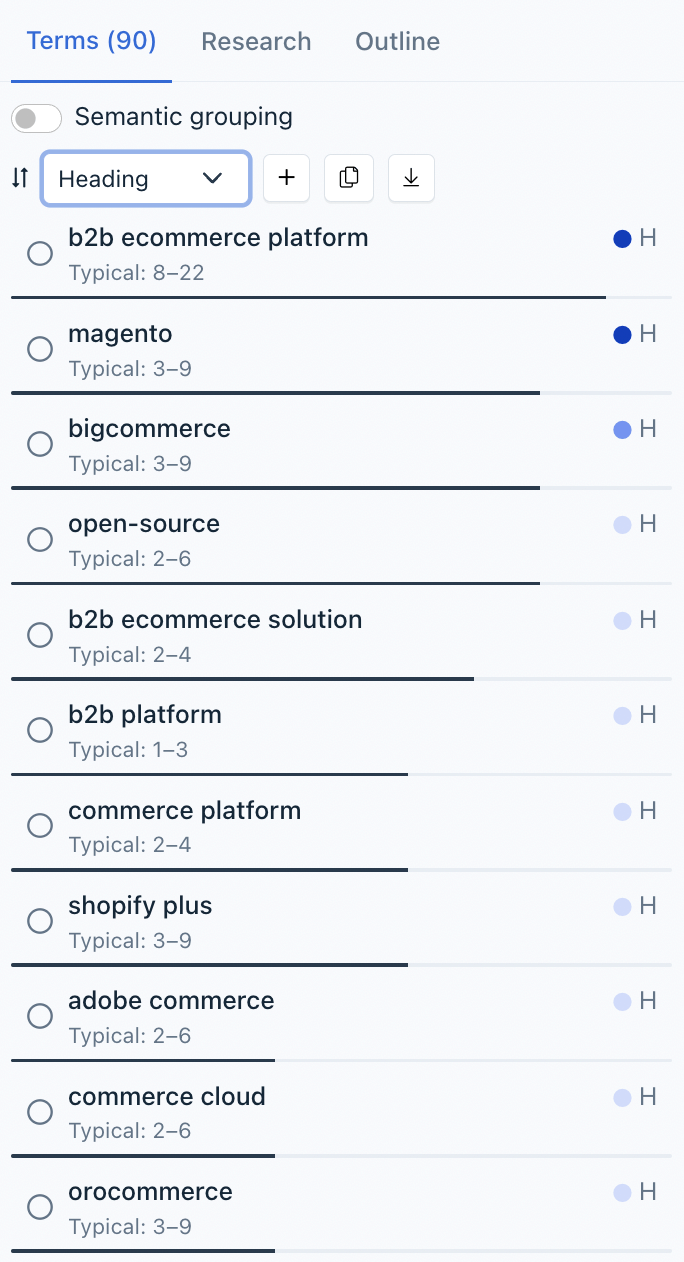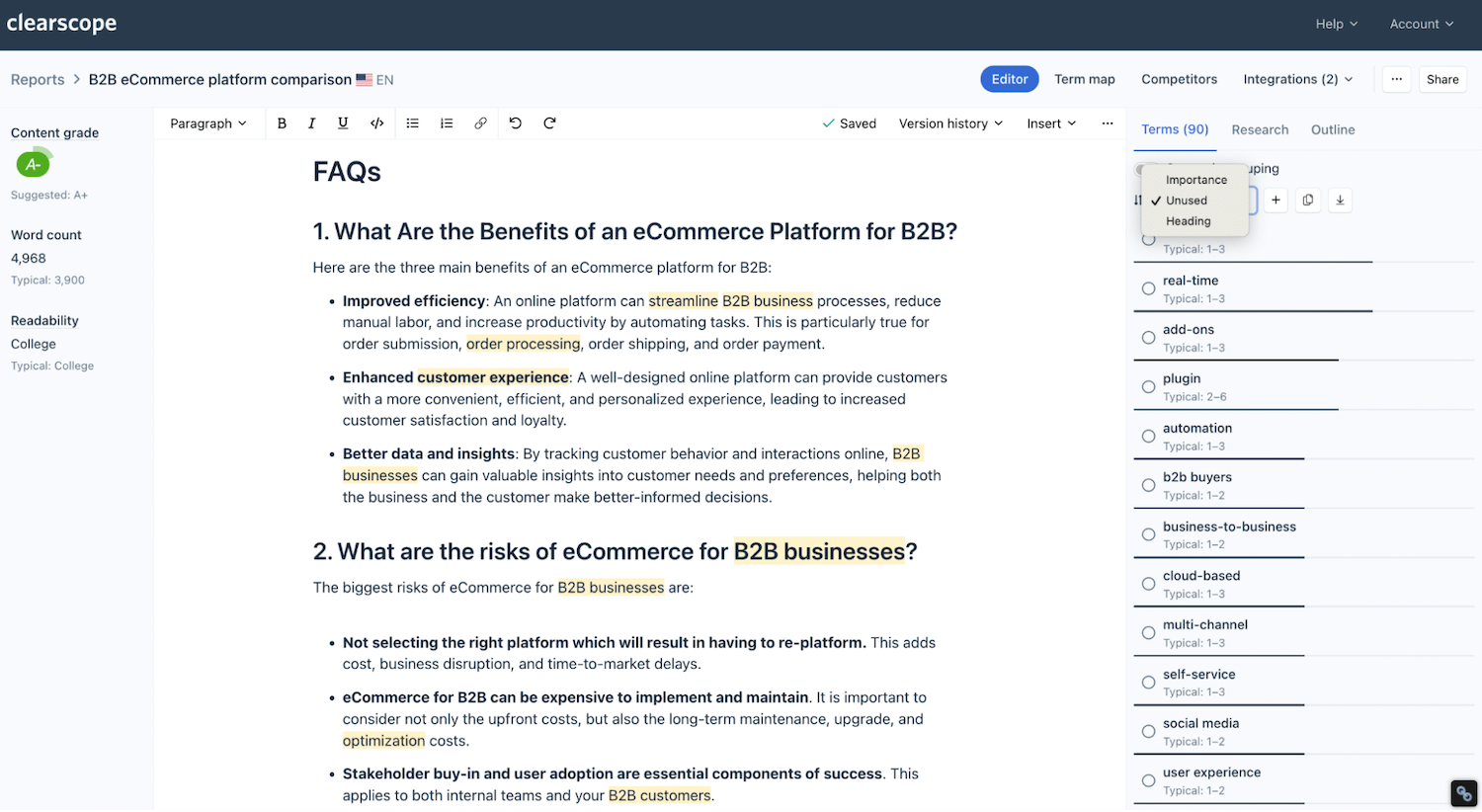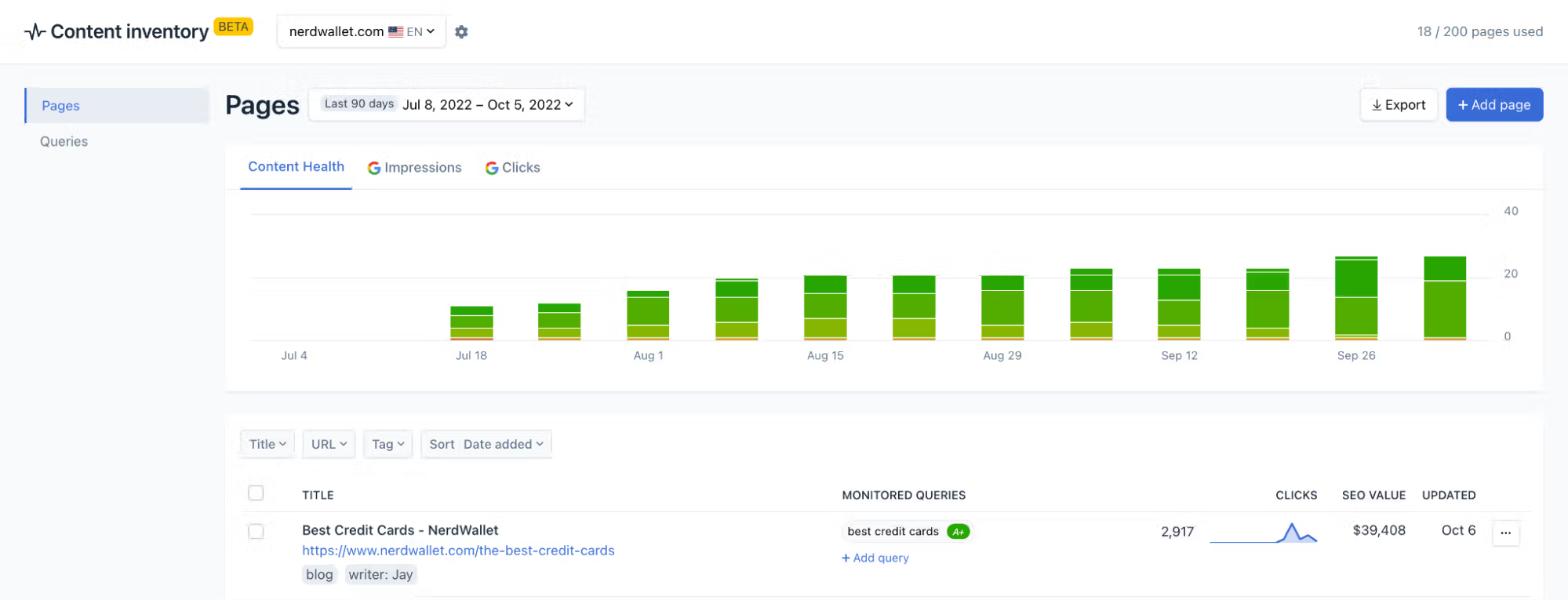
Table of Contents
Join our newsletter
Get access to trusted SEO education from the industry's best and brightest.
The ability to create unique SEO content involves a few things:
Clear knowledge of the target keyword and topic you’re writing about.
Understanding your readers. What is the goal of their research? What are their challenges? What solutions do they want?
Understanding your competition and what’s already been written on the topic.
Brainstorming your positioning and angle. How do you fit into this conversation? Can you provide new value to these readers?
Following on- and off-page SEO best practices to set your content up for success in search engines.
Creating unique content is critical to performing well in organic search — and maintaining search engine rankings — because search algorithms are far more likely to rank original content that delivers new insights. In fact, they’ll knock your content if it has duplicate copy (on another page of your site) or if algorithms detect plagiarized content (ripped from another source).
Think about it: If you were researching a topic and clicked through a few Google results, but they all repeated the same information in different words, you wouldn’t find the results very helpful. You want to learn something new as you progress through your research.
So we put together this guide that talks more about each criterion above — we show you how to refine writing workflows so each piece of content you produce provides unique value and checks all the boxes to rank highly in search engines.
Our content optimization tool, Clearscope, provides various features (keyword research tools, SEO reports, and Content Inventory) to streamline your processes. We give you the tools to research topics and competitors, write SEO-friendly content, and follow SEO strategies to improve and preserve rankings.
Let’s get started!
You can also contact us for a free demo to learn more about unique content creation in Clearscope. Or, you can explore our platform and features here.
Step #1: Topic research
The most straightforward method to write unique content is to write from your viewpoint — you can weave in “originality nuggets” by dropping in your background knowledge and personal experience, opinions on the topic, advice, takeaways, etc. “Here’s what I know about the topic; here’s what I can tell you about it.
But you can only do that (and offer readers truly helpful, accurate, and reliable information) if you’re knowledgeable about the topic and confident in what you’re talking about.
So, in-depth research is an essential first step.
Start by searching the target keyword and performing SERP analysis — reading what’s already been written on the topic gives you background knowledge, shows you what’s relevant to readers, and lets you assess the competition; all in one fell swoop. But you don’t want to stop there.
You should also research related keywords — you can find these by looking at secondary keywords in keyword research tools or by seeing what search engines recommend in the related searches section. Also, look at common questions about the topic (in People Also Ask) to understand what Googlers want to learn in their research.
Of course, you can expand your research as necessary while you learn about the topic.
Be sure to give yourself ample time for this research; the information you gather here is critical to building a solid outline and writing high-quality content — with new, unique insights.
It’s worth noting: Google E-E-A-T considers the experience, expertise, authority, and trustworthiness of content and authors because it wants to provide credible information to readers. Targeting topics you know about or are an “expert” in means Google is more likely to rank your content for those keywords. For example, if you’re an IT expert writing for a tech brand, and decide to tackle a post about sleep problems, you might have trouble out-ranking sites more tailored to the topic.
Quick tips to research:
Look up the target keyword and read through the content that currently ranks in SERPs.
Research related and long-tail keywords.
Look at questions people ask and snippet features.
Refer to multiple sources.
You can use Clearscope’s Keyword Discovery tool to perform this research.

Simply type the target keyword into the search bar, and we’ll show you a list of related keywords — you can filter by trending topics or common questions and explore long-tail keywords. Then, you can open the search engine results page to continue researching user intent and competitor content.
Step #2: Analyzing search intent
As you explore the topic and assess what’s already ranking in the SERP, consider the searcher, the exact search query, and the goal of their research.
Who is the target audience?
What is their current problem?
What solutions or information are they searching for?
What is the preferred/ideal/best solution?
How can you relate and appeal to readers better than competitors?
You want to center yourself in the readers’ shoes to understand their current situation and what they want to achieve by the end of their search. Understanding readers also makes brainstorming fresh examples easier; examples add to the uniqueness of content and make content more relatable to show readers you’re on the same page.
Pro Tip: If you’re writing content to promote a particular product or service, you can also read customer reviews and forums to understand more about your target audiences’ pains and feedback about competitors. This can help you brainstorm strategies to improve your content marketing and other crucial elements of your business operations (how to improve products, provide better customer service, etc.).
Read more: Your Guide to Analyzing User Intent for Better SEO Results
Step #3: Comparing competitor content
Now is the time to determine your strategies to outperform competitors — and say something new. Part of topic research (step #1) involves analyzing competitor content, but to write unique content, you have to take a deeper look at competitors’ strategies.
What type of content do they produce on the topic? (Are they writing blog posts? Or are they targeting the keyword with a product or website resource page?)
What topics does the content cover? (What’s important to the reader? What feels unnecessary?)
What are they specifically saying about the topic?
What solutions/answers do they provide to readers?
As a reader, what is the content missing?
Then you can use these insights to carve a niche for your content.
Take notes while researching to reference your takeaways and ideas as you build your outline. You should have a good understanding of what competitors say about the topic, but you shouldn’t focus too much on competitor content or continually reference competitors as you write. It’s easier to write from memory once you have a good idea of where you fit in.
Read more about this step: Competitive Content Analysis: Your Step-by-Step Guide
Step #4: Understanding where you fit in
Once you wrap up the research process, you can begin building your content; this is where the bulk of the creative work comes into play.
Before outlining, think about:
The kind of content to produce. Do you plan to target the keyword with a blog post? Should you design a website page?
Your positioning. How will you hook readers and keep them engaged with your content? What is your unique angle?
The key topics you want to cover.
Your solution. Consider your brand, offerings, and experience; what can you offer readers? What new value does your content provide?
And Clearscope SEO reports help with all of this. Once you run an SEO report for the target keyword, we show you:
Your top SERP competitors and their content’s SEO scores (this can help with the step above, too).
Main themes to cover in your content.
Important questions to answer.
Suggested terms and phrases to include in your content.
Standard outlines (to see main ideas and gather ideas for your content).
Then, you can begin forming your ideas around our recommendations. For example, if you’re designing a landing page for a product-specific keyword, you could see the main topics, questions, and benefits to discuss, then determine the best strategy to sell your solution.
Let’s talk more about content creation.
Build Your Outline
First, draft your introduction and begin outlining content.
You should base the introduction around your unique messaging — what new information can you give readers to interest them in reading the rest of your content?
Don’t waste time repeating what competitors say or focusing on general background information. Offer fresh perspectives and original takes on the topic.
Then, a few things to consider as you outline content:
It should have a unique structure but be easy to follow.
It should cover the main topics and answer core reader questions.
Headings should have clear, concise phrasing to improve scannability.
You can look at basic outlines in our SEO reports, but we also show you suggested terms and phrases for headings (and the importance of each heading); this makes it easier to touch on main topics while weaving in your creative angle.

You can also add unique FAQs to cover relevant topics and drop fresh details into your content. These present an opportunity to provide personal insights and help your chances of appearing in SERP snippets.
Read more: How to Write SEO Content Briefs and Outlines (Video + Template)
Draft, Edit & Optimize Content
Now is the time to draft content — our best advice is to write content in your unique style and voice… while accurately reflecting your brand personality and “speaking the reader’s language” (i.e., using familiar jargon, focusing on what’s relevant to them, and adjusting the tone of content).
The focus should remain on writing naturally; you don’t want to create frustration around checking off SEO requirements or reinventing the wheel. Simply offering new insights and specific solutions can be enough to set you apart.
A few other tips to consider as you draft:
Avoid repeating yourself (or competitors) and deliver new value from section to section. If you don’t have anything new to say, keep it moving.
Use examples, tell stories, and give first-hand advice. Showing that you relate to readers means they’re more likely to view you (and your solution) as trustworthy.
Talk about the “Don’ts” and things these readers should avoid. For example, if you’re writing a guide on the best travel credit cards, you should also include a section on cards to avoid or things to not do when applying for a credit card.
Loop in your brand offerings where applicable; don’t oversell your solution, but present it where it makes sense and can actually benefit readers.
Continually tie the content back to the reader's intent and speak directly to your audience. Again, connecting with readers, showing them you have the same goal, and delivering value lets you establish rapport and build loyalty.
Note: Throughout this post, we’ve stressed the importance of creating unique content around readers’ interests, and not so much about “optimizing content” (we’ll get to those tips later). That’s because content quality and reader engagement are two of the most important factors in performing well in search engines.
Even if you have a whole new topic angle or follow every SEO best practice, your content won’t perform well if it isn’t genuinely helpful to readers. Keeping reader intent at the center of content creation is key to successful content. (It also makes offering your perspectives and personal insights easier.) Then you have a solid foundation to implement SEO strategies and improve search engine rankings.
You can reference our SEO report’s recommendations to ensure you’re incorporating relevant topics and terms as you write. We also display your content’s readability score and SEO grade as you draft to show you if you’re working in the right direction.

Our reports are more user-friendly than those in other SEO content writing tools for a few reasons:
We don’t hit you with hundreds of recommendations.
All recommendations are unique, so you can avoid keyword stuffing.
We have a semantic grouping feature that makes it easy to weave recommendations into your natural writing.
Our platform uses NLP to accept variations of recommended terms and phrases; you can talk about topics in your way without feeling restricted to a specific list of terms.
Reports let you easily optimize content as you draft, then the editing process is much smoother. We also have integrations with Google Docs and WordPress, so you can access SEO reports in the other tools you use to draft, share, publish, and refresh content.
When it comes time to edit content, our reports Highlight what’s important for SEO so you can make adjustments without removing relevant details. You can follow your normal strategies here — perform a spelling and grammar check, improve tone and flow, and make sure details are accurate and up-to-date.
We also suggest looking at content readability to improve scannability and the user experience:
If you notice long sections, divide them into shorter blurbs or break the concept into bullet points.
Call attention to important points with bolding.
Rewrite long or hard-to-read sentences.
Use in-line media to support and break up content.
Read more: How to Write SEO Content That Ranks on Google
Once you’re happy with the actual content on the page, then you can follow our SEO strategies below to ensure your content meets all the requirements to rank (and move to the top positions) in SERPs.
Step #5: Follow SEO best practices to boost rankings and performance
Before publishing new content, you should:
Add internal links to other posts and website pages that relate to the topic. This makes it easy for readers to continue their journey on your site (reduces bounce rates), lets Google see the relation between resources, and builds structure across site pages. (Read more: 5 Effective Internal Linking Strategies to Improve Your SEO)
Link out to other websites with valuable information on the topic (think about the sites you reference in your research when adding these links). You should link to sites with high DA ratings and topical authority.
Use smart anchor text with internal and external links. Readers should know where links are directing them so it’s clear before they hit the page. We also suggest using secondary or long-tail keywords in anchor text to appear for related topics.
Add in-line media like images, tutorials, infographics, etc. Fresh visuals set you apart and make content more memorable to readers. If you have a design team, utilize them to create unique or branded media. Partner with research groups to add unique polls and surveys in content. Avoid the same stock imagery you see on popular sites.
Use relevant alt-text with media; this improves content accessibility and provides opportunities to include related keywords.
Write crafty SEO titles and meta descriptions — this is what readers will see when they find your content in search engines, so you want to have strong (clear, engaging, unique) titles to grab their attention and convince them to click on your content.
Double-check that you use the target keyword (or variations) in the right places, including the on-page and SEO titles, meta description, headings, and throughout copy. Be careful to not overuse the keyword, or your content might sound robotic or unnatural.
You can also check out our 10-Step Checklist for SEO Content Editing (with Guided Reports) to make sure you’re covering all of the important bases.
Off-page SEO strategies
After you publish, we recommend promoting content to get it in front of target audiences sooner and support search engine rankings.
First, you can promote content via paid ads or social media. You can run PPC campaigns through Google Ads to appear at the top of search engines for target keywords. (Then, once you achieve organic rankings, you can shift the ad budget elsewhere.)
Promoting content via social media helps you drive traffic to your site. If you can effectively drive traffic and keep readers engaged, it could help your site’s performance in search engines.
We also suggest building backlinks to website content — backlinks from other credible sites boost your content authority (and, as a result, can improve rankings). Plus, original content is more likely to get backlinks, so these efforts are usually easier when pitching unique content.
Read more: How to Get Good Backlinks: A Step-by-Step Guide
You can also build brand awareness and topical authority by staying active on your Google Business listing. Share new content by posting updates, respond to customer questions, add contact information, and more. If readers know about and trust your brand, Google will begin to recognize and recommend you in the right contexts.
Final notes
Monitoring content performance (post-publishing) is crucial to understanding which strategies work for you and where you need to shift gears.
After publishing, you should monitor each piece of content and measure:
Where it ranks for the target (and secondary) keywords.
How much traffic it receives (and where visitors find you — paid ads, organic search, referrals).
Reader engagement. Do readers stay on the page long? Do they convert from content? Or do they bounce after reading?
Current SEO scores. This tells you how well content is optimized for the target keyword and when it needs updating to stay competitive.
If you notice content isn’t performing as expected, follow some of our tips below to troubleshoot.
Consider technical SEO
If poor rankings are a problem, you could have issues on the back end of your site. Performing a technical SEO audit (with a tool like Screaming Frog or seoClarity) can show you if anything is going on with your site that’s negatively impacting rankings.
SEO website crawlers can identify broken links and expired redirects, issues with your URL structure, and problems with indexability. (Plus, the tools mentioned above are extremely configurable, so you can get as in-depth as you like with this analysis.)
You can also use Google Search Console to access core web vitals and address Google’s recommendations to upgrade site performance. You can see suggestions to improve page indexing, desktop and mobile usability, site speeds, and more.
Check your website for duplicate content
Many technical SEO tools will flag duplicate content, but you can also use a duplicate content checker to hone in on this if you’re concerned it’s an issue. These tools can scan through your website content and show you if pages have identical content — then you can identify the content that needs updates and make changes accordingly.
If you identify duplicate content, you can:
Update the page copy.
Use rel canonicals to link similar web pages and prevent search engines from seeing them as dupes.
Use 301 redirects to “remove” duplicate or outdated site pages and route readers to the right landing pages (while preserving the existing link authority).
We should note: duplicate copy is not usually intentional — it can sometimes appear in cases where writers write about similar topics (like the same products or services) regularly. These tools can prove helpful in checking product descriptions, call to actions, and other promotional copy to avoid flagged content.
It’s also a good idea to perform a content inventory and audit (and stay up-to-speed on new content) so you always know what exists on your site and how well it performs for you. This helps you avoid duplicate content in the future… and other big problems, like keyword cannibalization and content decay. More on that below.
Refresh existing content
If content ranks well and receives traffic, but readers aren’t engaging or converting from it, you should take another look at content and determine where you can make changes to see better results.
This takes you back to the research stage, but staying on top of content and making these changes ensures you can see ROI from your efforts. Letting content fall by the wayside is a waste of resources. Plus, in many cases, you can up engagement metrics just by improving readability, adding a clear call to action, or weaving in a few missing details.
In addition, you should plan to refresh content every so often so that it stays unique, current, and competitive.
Clearscope Content Inventory guides this process so you can time updates strategically and use our report recommendations to re-optimize content.

Here’s how it works:
Copy and paste your website URLs to the Content Inventory dashboard.
Add the target keyword for each web page.
Our platform monitors Google algorithm changes and competitor content to show your content’s current SEO score — you can log in at any time and see how your content performs in SERPs.
When you notice scores fall below average, you can schedule content for updates. Then you can generate a new SEO report for the keyword, paste your existing content, and follow our tips to make edits. In addition to following our recommendations, you should also:
Add new insights, details, or examples that are relevant to the topic or reader.
Replace internal and external links so they route users to updated resources.
Update in-line imagery (especially infographics) and ensure alt-text aligns with new media.
Read more: Best Practices for Updating Website Content (2023 Guide)
Risks of copied content & plagiarism
If you’re interested in producing unique content, you’re likely already aware of the risks associated with duplicate content. However, we’d be remiss if we didn’t discuss some of these issues.
First and foremost, duplicate and plagiarized content hurt rankings. If Google sees you’re copying content (either from yourself or somebody else), they’ll view your content as less credible, and you as less trustworthy. At first, you might see individual page rankings drop, but if duplicate content is a recurring issue, Google could knock your entire site, and all of your rankings can suffer. And it can take a long time — a couple of years, in some cases — to recover from these penalties (even if you follow the right strategies to fix and promote content).
Plus, ripping content (even images and in-line media) from other sites is considered content theft and can land you in actual legal trouble.
Moral of the story: don’t cut corners. Plus, producing unique content is more interesting, anyway.
Avoid AI content generators
Using AI generators won’t necessarily land you in hot water from a legal standpoint, but they do put you at risk of publishing repeat content on your site. Although these tools are becoming increasingly popular, they basically provide the opposite of unique content. And could cause tedious issues later down the line… as discussed above.
AI content generators analyze what already ranks for a keyword, then spit out a new version of that content. This “new” version isn’t necessarily unique, it’s just repeating the same information in different words. In essence, it creates duplicate content.
If your goal is to produce genuinely unique content, AI generators won’t help in the process — even if they seem time-saving. We don’t recommend trying to remix AI content, either, as it’s usually more frustrating than beneficial. However, a well-crafted AI prompt can generate interesting ideas to discuss in your article.
Get started in Clearscope
Knowing what to talk about, and how to talk about it, is the plainest way to create unique content. Why? Because uniqueness comes from offering personal perspectives, new examples, and fresh value; this lets you connect and engage with readers to develop long-term relationships and build reader loyalty. If you’re unsure about a topic or don’t feel confident speaking on a subject, you’re more likely to spit out the same information as your competitors.
Clearscope helps you in the research process so you can understand how to strategically tackle topics, and we provide user-friendly SEO tools so you can tailor content to search engines in your natural writing workflows. We provide clear direction and straightforward suggestions so it’s easy to blend your creative processes with SEO best practices.
Explore our platform to learn more about producing unique content in Clearscope. (You can also contact our team for a free demo and consultation.)




